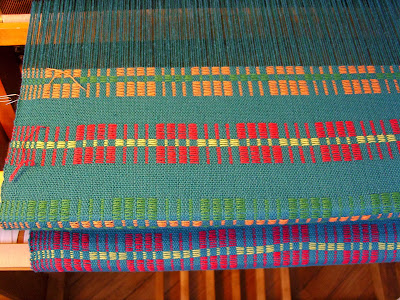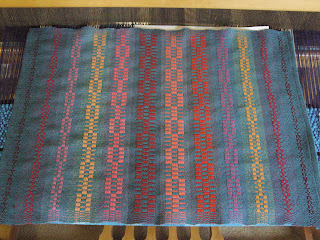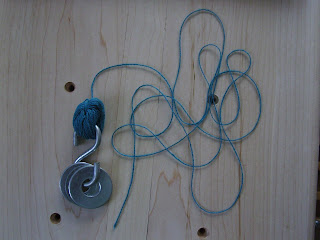This year, I got an early start when I came home from vacation in April with a big cone of 8/2 cotton yarn in a teal color. I decided on a monk's belt pattern from Handwoven Design Collection #18. I wound the warp for six towels and started the threading in June. It was a good thing I got an early start, because I was diagnosed with ovarian cancer early in July and had major surgery a week later. While recovering from surgery, I sat for many days looking at the loom that was partially threaded. As I started feeling a bit better and became bored doing nothing, I decided to see if I could finish the threading.
Working a few minutes at a time, I got it ready for the first towel. Now, all I needed were yarn color choices from the girls. Three of them were here a week later to check up on me and to come for the Charlevoix Venetian Festival. They picked their colors and I was able to start.
Carolyn's towel was first. The colors she chose were light orange, red, green and yellow. The yarns used were 8/2 cotton.
After weaving this one with a single strand of yarn for the pattern, I decided the rest of the towels needed the pattern yarn to be doubled. Also, the green she chose didn't show very well because it was too close in color value to the teal warp.
Rachel said she wanted her towel to be mostly white pattern, but I made her pick two other colors to add a little interest and to give me something to work with in developing the pattern. She chose light orange and yellow. It was my plan for each towel to be completely different from each other, even though they were woven on the same warp and all threaded the same. I think this one came out very nice. The colored yarns are all 8/2 cotton. The white is 50/50 cottolin in a similar size to the cotton, something like 22/2. It is too cold to go outside to the studio to look.
My DIL Jenn's towel is the orange and lime green towel on the left. I tried to tone down the teal by weaving the tabby with brown and olive green 8/2 cotton. The orange and lime green are both cottolin.
These towels were all pretty slow going, since it took me a long time to recover from my surgery. As I started my chemotherapy treatments, they gave me something to focus on besides being sick. They were quite good therapy.
This towel is for my DIL Rebecca. She wasn't here to pick her colors, but she loves anything blue, so my daughters and I picked for her. I used
navy, wine, ocean green and light blue.
As I was working on this towel I managed to break my hand doing something I shouldn't have been doing. My doctor splinted it, but I could tell a few days later that it wasn't going to heal that way because every morning when I woke up, the splint was out of position and the bone was bent at the break.
I had our hand specialist at work look at it after the weekend and he set it and put in into a cast. It was much more comfortable after getting the cast but I still wasn't supposed to use it, so weaving was put on hold for a few weeks.
I was then put in a removable splint since it was starting to heal. I was happy because my doctor was worried that the chemo would slow the healing. It didn't, and I was able to start weaving again.
I was able to finish Rebecca's towel and get started on the last one needed for Christmas. This towel was for my daughter Becky. She chose off white, navy, red, light orange and light green. The eleven treatments I was getting for the cancer was taking a toll on me though, so I couldn't weave for very long at any one time. I was getting a bit worried that I wouldn't finish it in time. I had a good week when I had a week off from chemo and was able to finish it.
It is always nice to have a little warp left over to make something for myself. My favorite color is red, so I dug through my box of yarns that I had dyed and found quite a range of pinks to reds to purples and came up with this towel. It is my favorite.
Group photo. I was very happy to finish all of them before Christmas.
An incidental note about this warp. When September rolled around, I heard from a friend who also has ovarian cancer that September was ovarian cancer awareness month and their color was teal.
I am not much of one for following all the color fads for all the different "awareness" months or weeks, but I guess it does give me an opportunity to inform women that there is no screening test for ovarian cancer, and because symptoms can be kind of vague and attributed to other things, most ovarian cancers are not caught until later stages.
Here is a list of symptoms, with the first four being the most common:
1. Abdominal or pelvic pain.
2. Increased abdominal size or persistent abdominal bloating.
3. Needing to urinate often or urgently.
4. Feeling full after eating a small amount.
5. Changes in bowel habits.
6. Bleeding after menopause or in between periods.
7. Unexplained weight gain or loss.
8. Lower back pain.
9. Indigestion or nausea.
10. Excessive fatigue.
11. Pain during sex or bleeding after sex.
Out of the eleven symptoms, I had eight of them. If any of these symptoms are new to you and you experience them frequently over a 2-4 week period, talk to your doctor and besides checking for other causes, ask him or her about the possibility of ovarian cancer. My stage 3c cancer was found with a CT scan. I was referred immediately to a gynecologic oncologist and was in surgery the next week.
I wish I had known this information months before I was diagnosed. Hopefully this list will help someone else to seek treatment in an early stage. Having the symptoms doesn't necessarily mean you have cancer, but checking the symptoms with your doctor could possibly save your life if it is and is caught early.
Now, I am looking forward to a better new year in 2014.





























































